Easy Nihari (Pakistani Beef Stew) – Stovetop + Slow Cooker
Here’s an easy Nihari (Pakistani Beef Stew) recipe that requires 1 pot and less than 30 minutes of initial prep time. This recipe includes stovetop & slow cooker instructions for tender beef shank (or stew) meat.
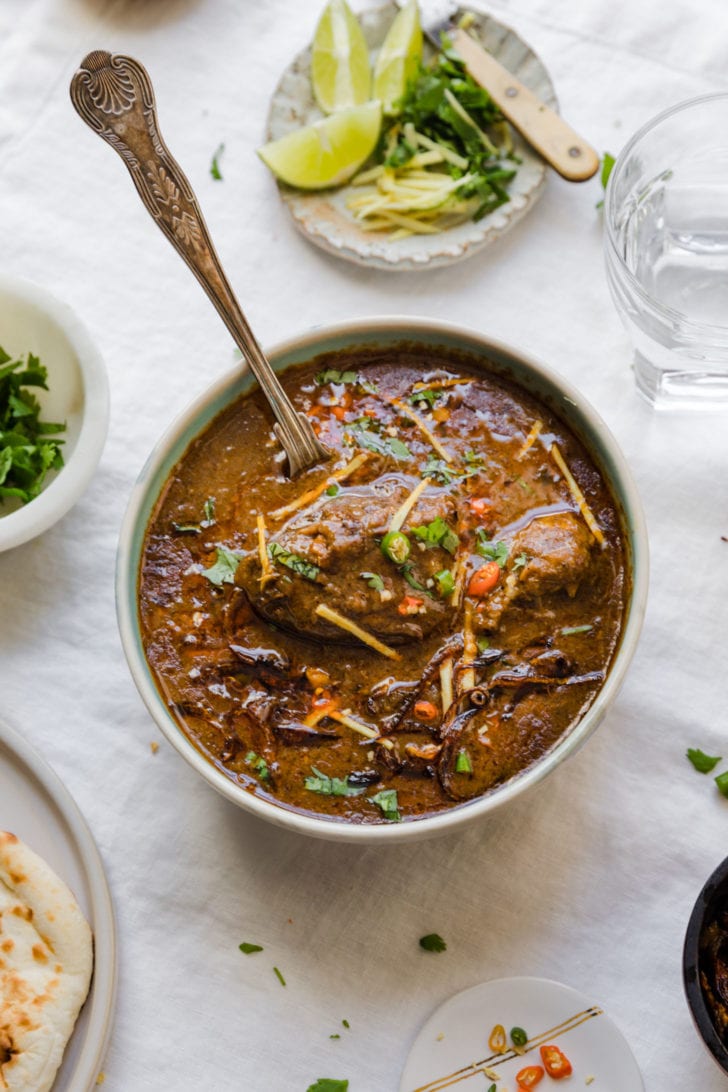
Want to save this post?
Enter your email below and get it sent straight to your inbox. Plus, get recipes & tips every week!
“Loved this recipe so much! I just made it for my boyfriend for his birthday and he said it was a solid 10/10 lol.”
Kimberly
Five years ago almost to this day, I published the slow cooker version of this Nihari recipe. Since then, it’s consistently been one of my most popular recipes. To be honest, I’ve often thought of improving it. (I’m always learning!) But, I dare not touch it since so many people have loved it over the years. I did update a couple things that were long overdue:
- I’ve shared stovetop instructions because are we still using slow cookers in 2021? (Psst…For those who’ve moved on to Instant Pots, here’s my Instant Pot Nihari recipe.)
- I’ve given the option to use homemade Nihari Masala.
Combine both things and I have to say, I like it even better than my original.
What is Nihari?
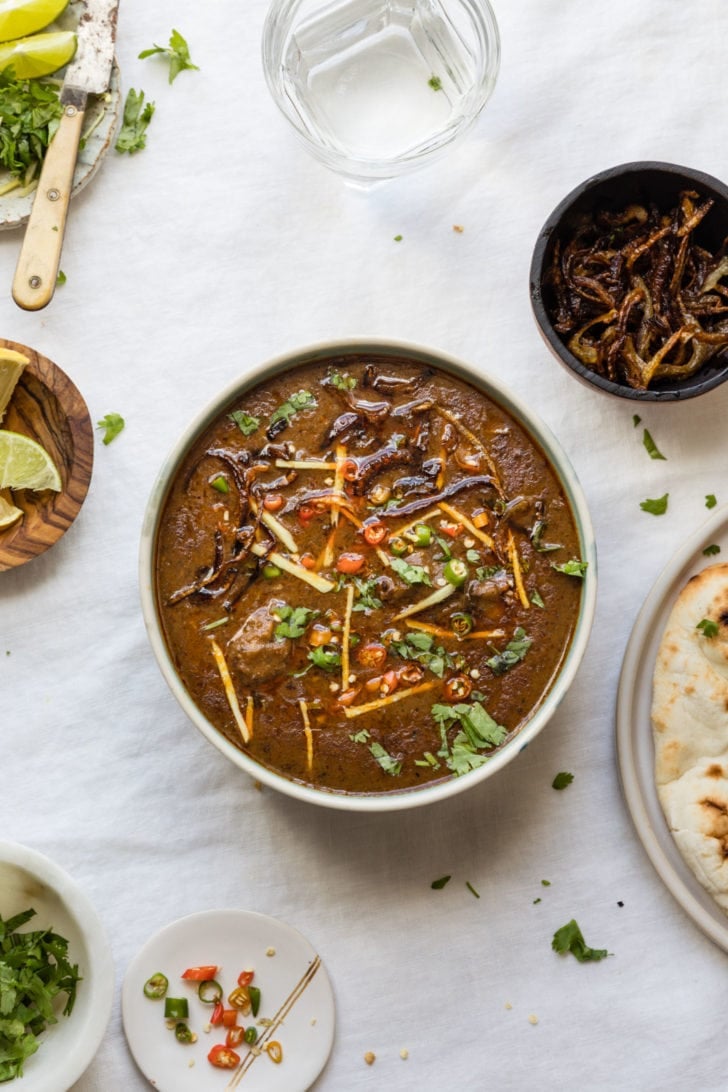
Nihari is a rich, slow-cooked meat stew flavored with spices and thickened with atta, or Pakistani & Indian-style durum whole wheat flour. Pakistani versions of Nihari are typically made with beef, but Nihari can be made with lamb, goat meat, or chicken.
The word “nihari” comes from the root Arabic word “nahar”, meaning “day” or “morning”. This dish is called Nihari because originally, it was eaten in the morning. The history suggests that it started in Old Delhi, where it was eaten by Mughal nawabs and workmen to fuel them throughout the day.
What is Nalli Nihari?
The word nalli means pipe or tube, which conveys the pipe-like bones that are used to make nihari. Nalli Nihari is made with beef bones (typically humerus or femur), which contain yellow bone marrow. This gives Nihari a rich, buttery flavor. Sometimes, the bone marrow is extracted and added to the Nihari.
This recipe doesn’t require bones, but using bone-in meat or bones alongside the meat will enhance the flavor (it’s more essential in the Instant Pot version). If you do use bones, you would need around 1/3 lb extra weight in bones.
Nihari Ingredients
Other than an unapologetically long list of spices, Nihari requires simple ingredients commonly found in Pakistani cuisine:
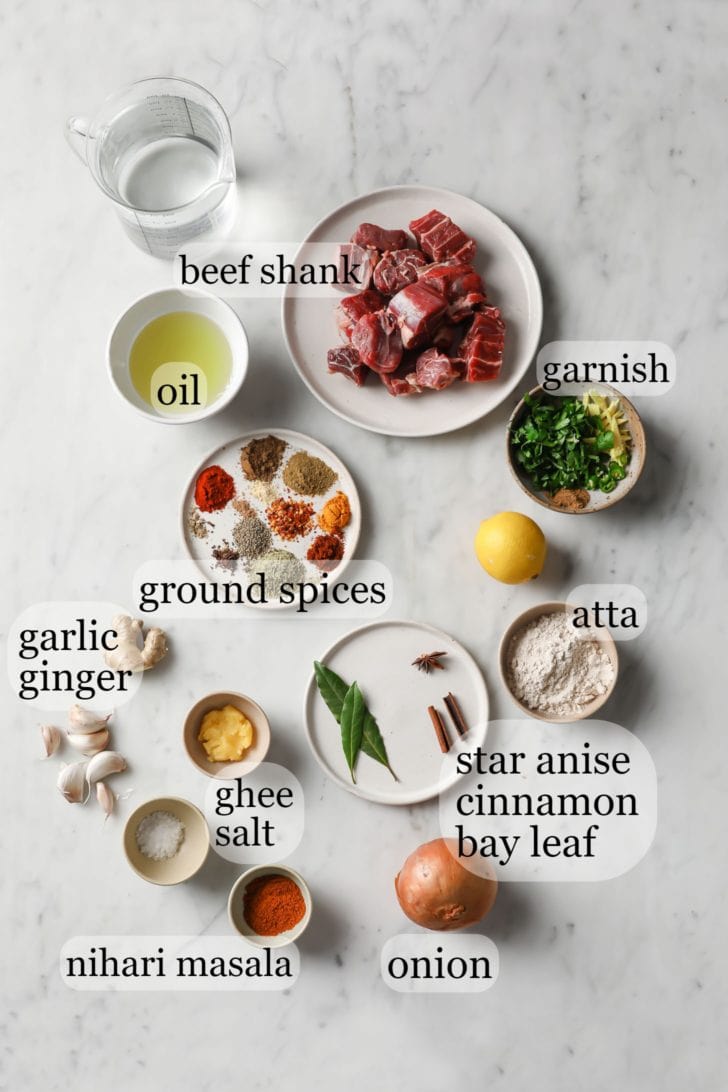
- Atta – Traditionally, atta flour, which is typically used to make rotis, is added to thicken the curry. I highly recommend you use this for an authentic taste.
- Substitute: All-purpose flour. I haven’t tried it myself but have heard from many who have. For added complexity, dry-roast it on a nonstick pan for 6-7 minutes on low-medium heat. It’ll turn a deeper, golden color.
- Spices – This recipe requires either store-bought or homemade Nihari Masala Powder (recipe below!) along with a few other whole & ground spices. As always, if you’re missing a spice (or three!), don’t let that deter you from making it.
What Cut of Meat to Use for Nihari
Nihari is typically made with boneless beef shanks, also called beef shins. Halal grocery stores will often have it labeled Nihari cut. You can also use pre-cut beef stew meat, which is essentially boneless beef that comes from the front shoulder (chuck) or rear muscle (round). If the type of stew meat is specified, I look for shoulder, as I’ve found it to be more tender.
Also, try to find good quality beef. The more marbled-looking it is, the better.
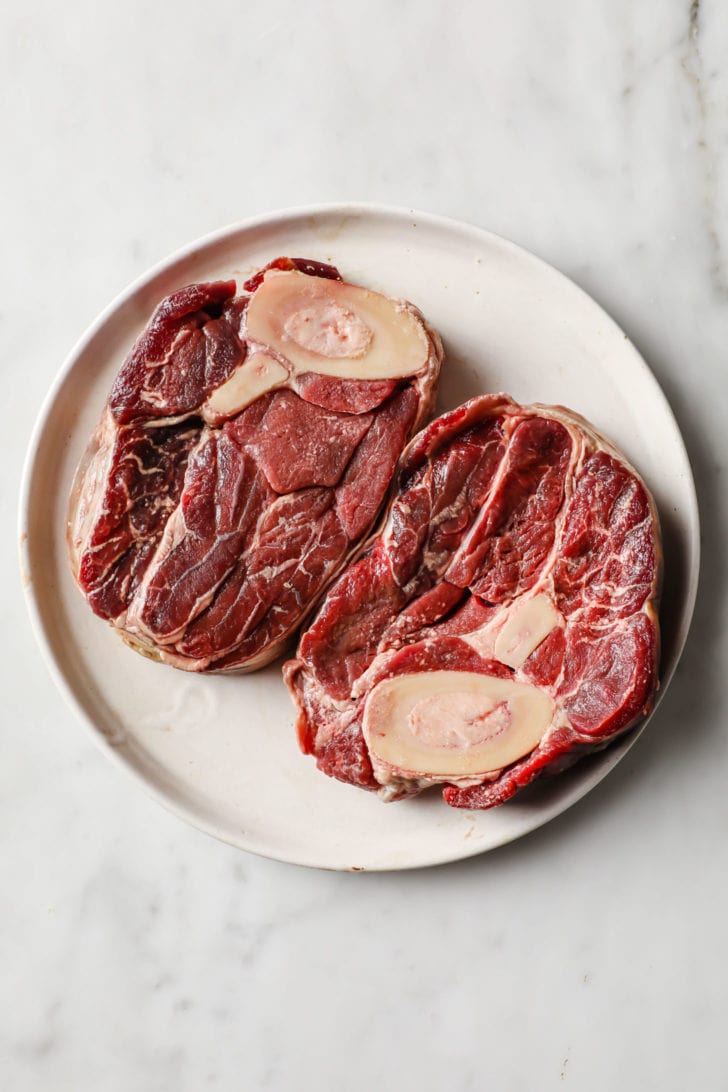
Nihari Masala
Using Pre-made Nihari Masala
Because Nihari demands so many spices, I originally created this recipe using 1/2 a tablespoon of pre-made Nihari masala powder. Use too much of the powder (like the whole packet as the box suggests) and you’ll end up having Nihari that tastes a bit manufactured and a lot like your fellow Pakistani neighbor’s Nihari because they used the same powder. Use just a bit and it’ll give your dish an extra oomph and good color.
Also, I’ve had many questions about using *just* the spice mix. I’m not above using pre-made spice mixes, but I prefer not to use the suggested quantities because it can taste quite harsh. Plus, the flavors are just more pronounced when you use fresh spices. Keep in mind that you’ll need to adjust the salt/spice level depending on which brand and how much masala you use.
Homemade Nihari Masala
As always, I prefer to use fresh, homemade spices when I can. It took me a while, but I finally created a Nihari Masala Powder that works with this recipe.
Nihari Masala – makes ~1 tbsp, all of which you’ll use
- ½-1 tsp Kashmiri red chili powder or paprika, for color
- 1 small black cardamom pod
- 1 small (1- inch) mace blade (or piece of mace)
- 3/4-inch peepli (long pepper)
- 1/4 tsp fennel seeds (saunf)
- 1/4 tsp garam masala powder
- 1/4 tsp ginger powder
- 1/4 tsp onion powder
- 1/8 tsp caraway seeds (shah zeera)
- 1/8 tsp nigella seeds (kalonji)
- pinch cane sugar
To make this Nihari Masala powder, combine all of these ingredients in a spice grinder and process until a powder forms.
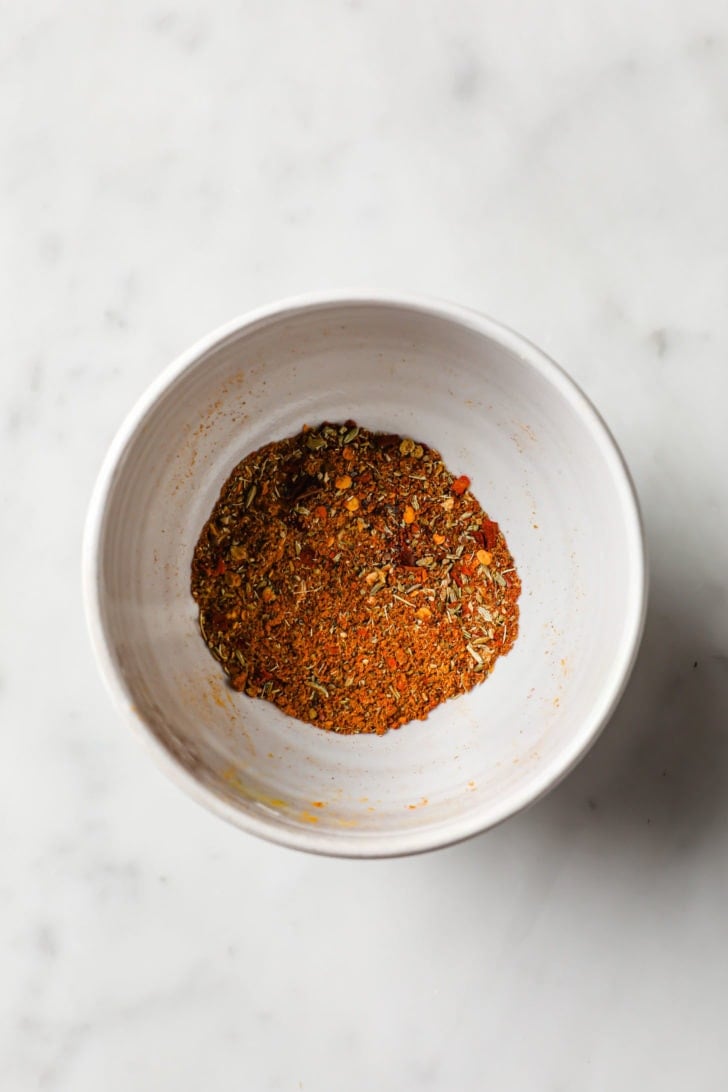
How to make Nihari
The key to a great nihari is intentional depth of flavor. Deeply brown onions, fresh spices infusing the oil, meat that’s properly braised..all this contributes to the revered taste of nihari.
- Brown the onions & meat. Deeply brown onions (refer to the video rather than the pic for reference) give flavor, body, and depth to Nihari. Like with most stews, searing the meat so that it browns is essential, but don’t sear for too long as it can lead to tough meat.
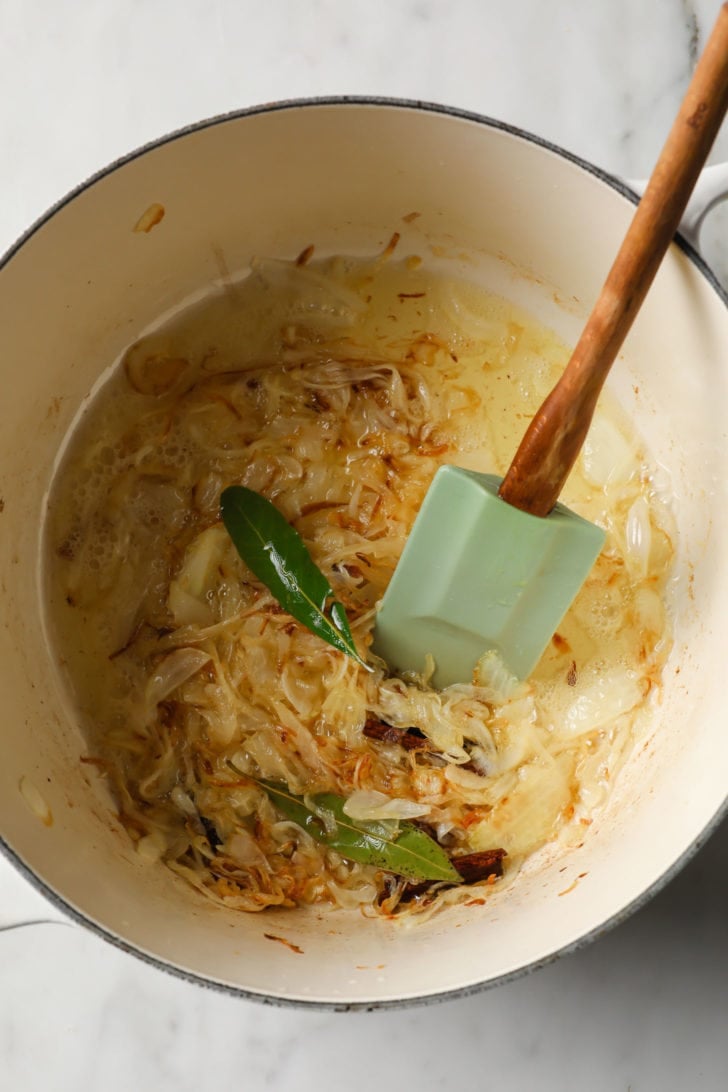
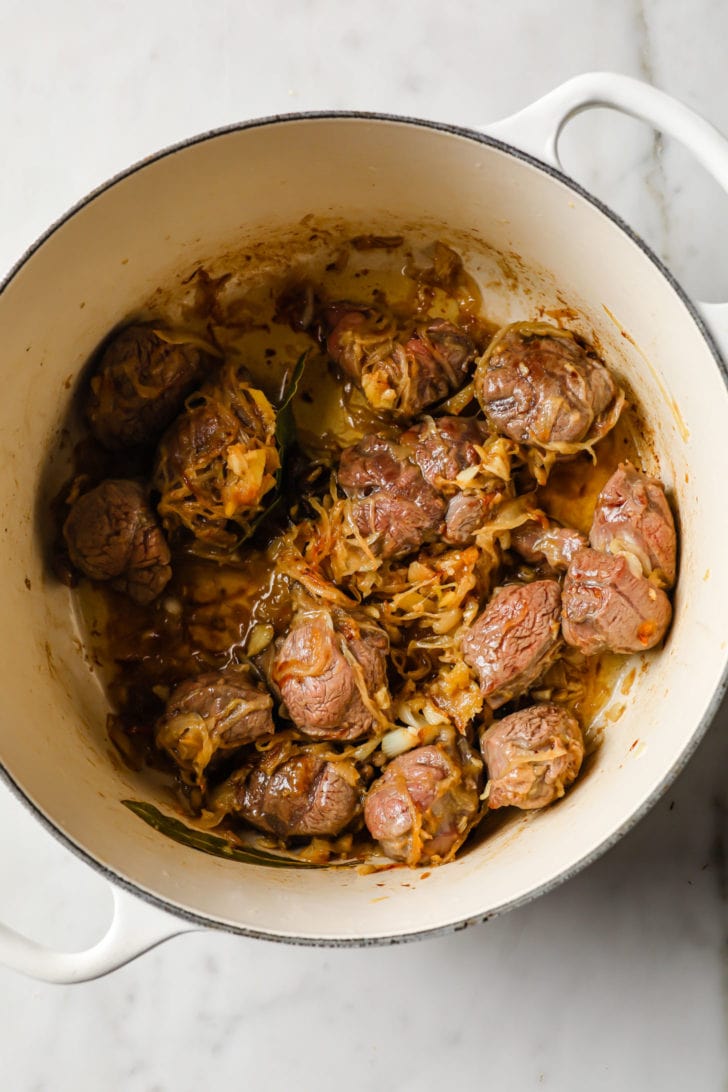
- Bloom Spices. Add spices and allow them to cook in the hot oil. If you’re worried about them burning, you can always add a splash of water.
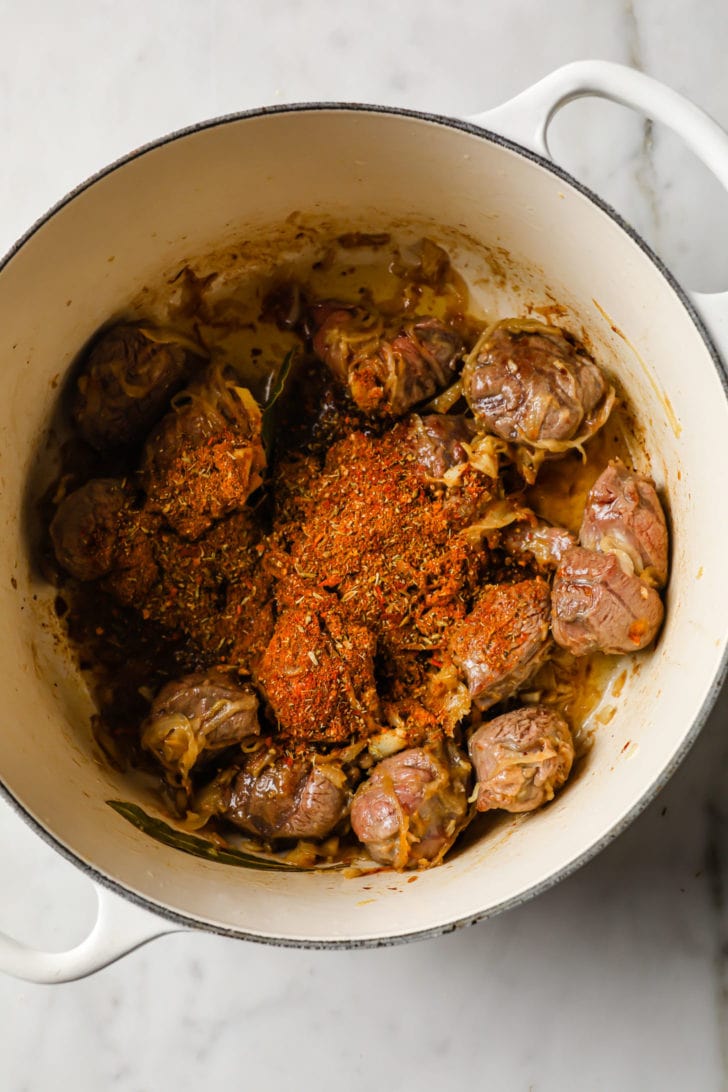
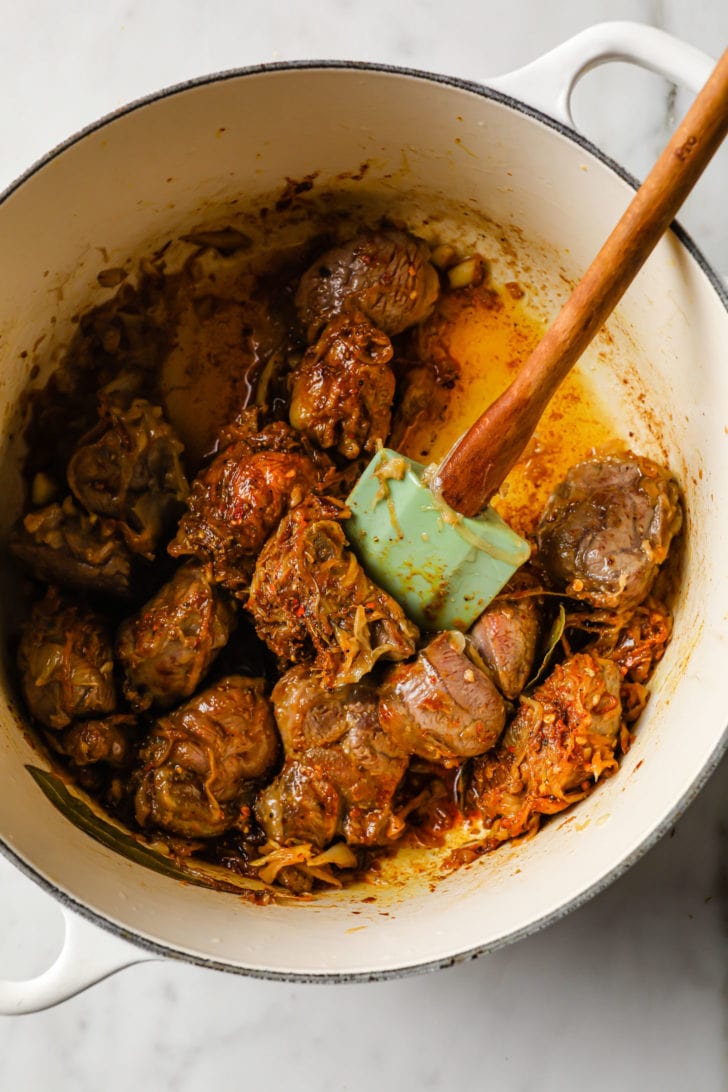
- Cook. For stovetop, allow it to come to a boil before lowering the heat to a simmer. For slow cooker, transfer the mixture to a slow cooker, add water and mix to combine.
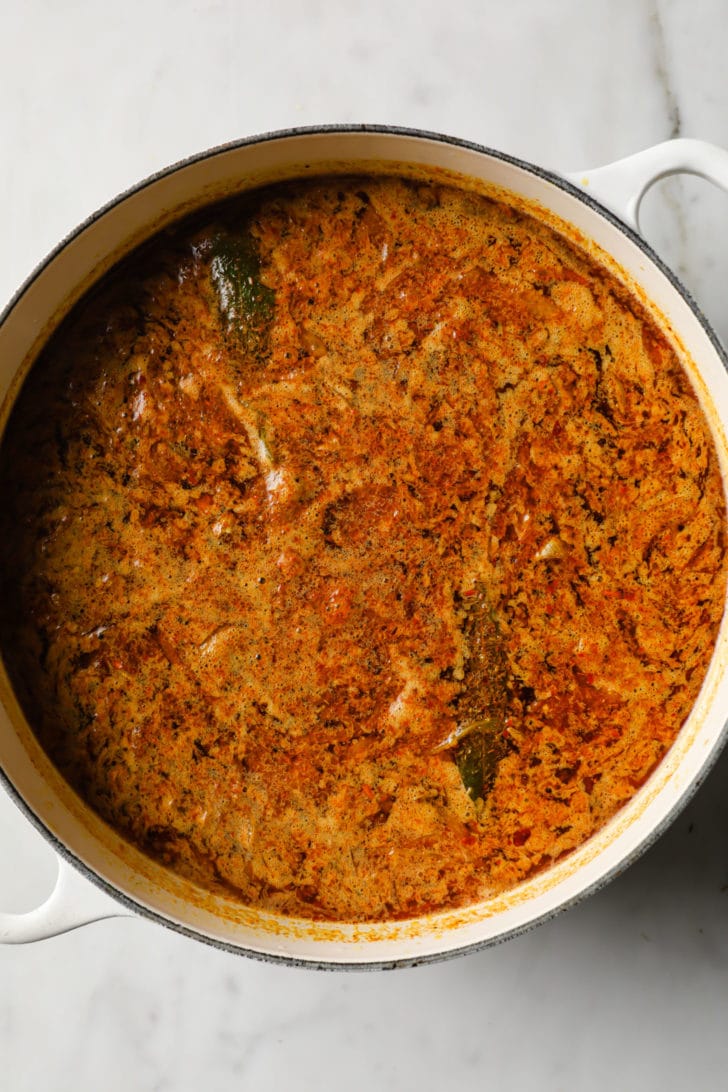
- Thicken. If you try to thicken the gravy by adding in flour, it will result in clumps. To avoid this, remove some of the nihari liquid (I always found using water dilutes the taste) and allow it to cool. Then stir it into the atta flour. Add this slurry to the nihari while stirring to prevent clumps. Allow this to cook and thicken.
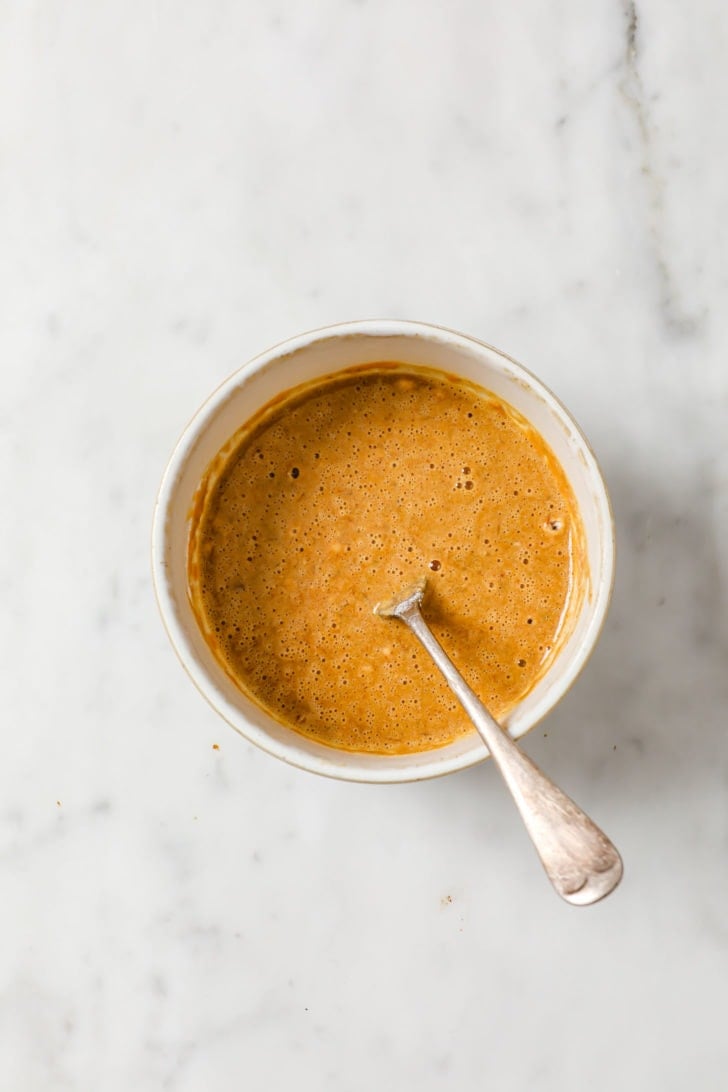
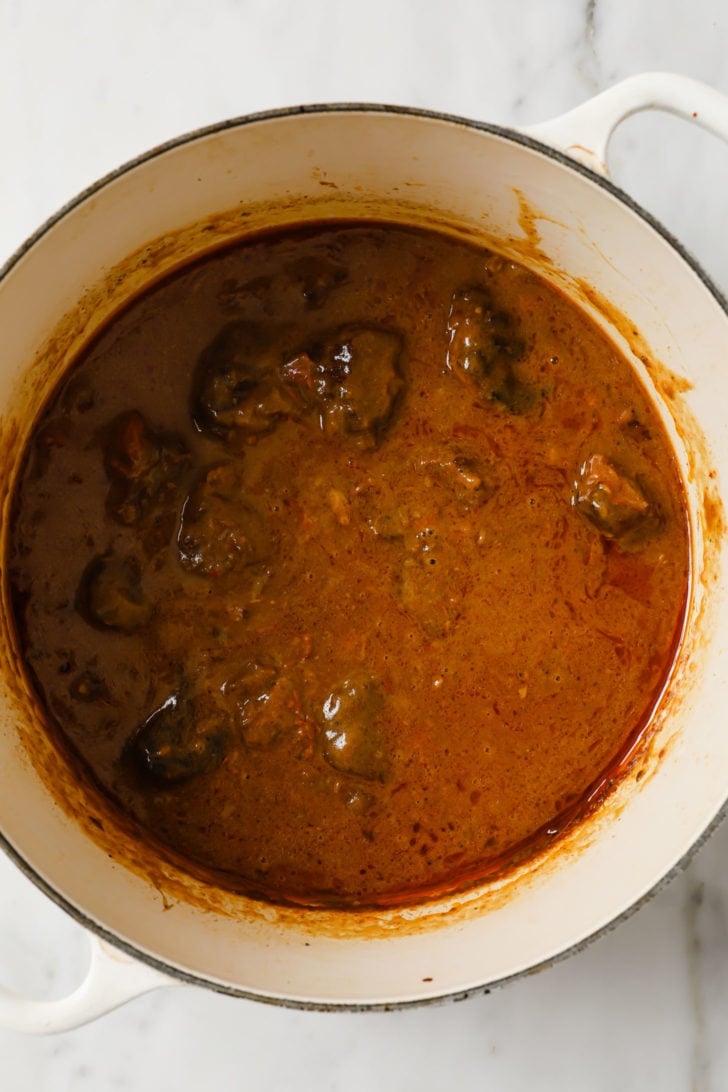
How to get the oil (tari) on top of Nihari
Once a curry is cooked, the fats and oil naturally surface to the top. Typically with Nihari, the oil releases once meat has cooked and also once the atta is cooked. Since I don’t use as much oil as some traditional recipes, it won’t appear as oily as most restaurant Niharis.
To the get oil to rise to top, allow to simmer uncovered on low heat for 5 minutes after you’re done cooking. You can also either reserve oil before adding the atta or add a tarka (tempering of oil) with spices to give Nihari its distinct layer of oil on top.
More Tips for Making Nihari
- Nihari meat should be very tender. It’s not done once cooked, but when it’s practically shredding to the touch.
- The end result should be like a thick soup or gravy. If it gets too thick, simply add (preferably boiling) water to thin it out. Sauté again to desired consistency.
- If using a slow cooker and the end result is too thin, transfer to the stovetop to thicken to your desired consistency.
- Restaurants will often keep the pieces very large (~3-4 inches). Kenji López-Alt points out that large cuts keep the meat more tender. I typically go for smaller sized cubes because it’s easier to eat & serve than a handful of large chunks.
- Variation: For more body and slight tang, whisk in 1-2 tbsp yogurt to the atta slurry before adding it to the Nihari.
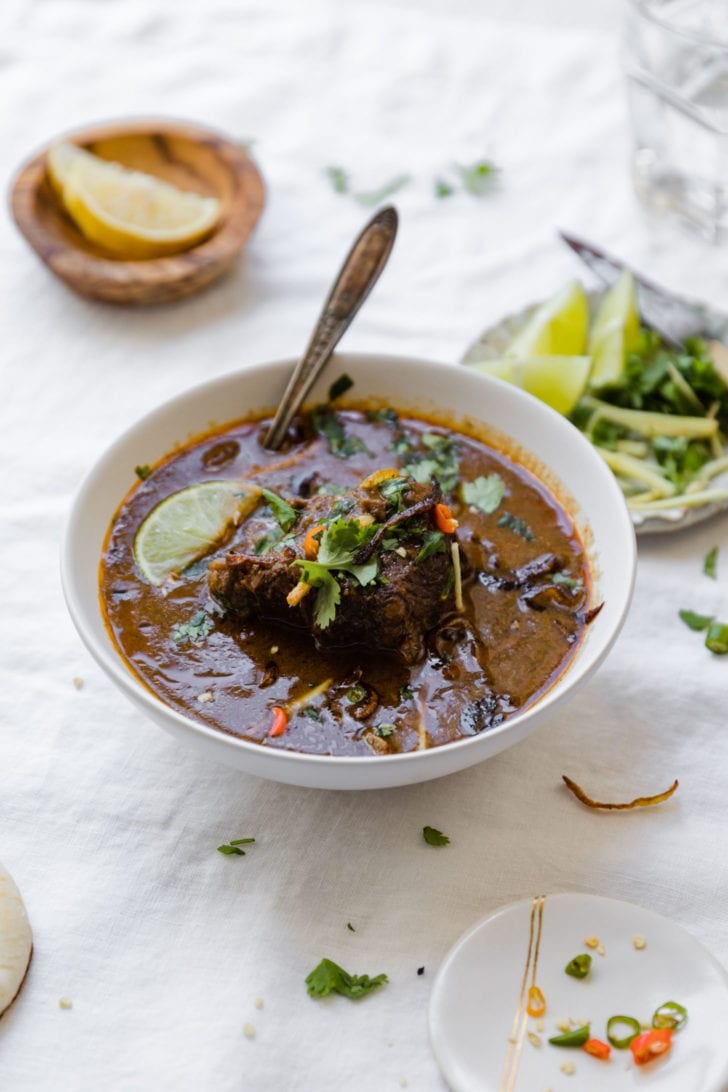
How to make Gluten-Free Nihari
After several experiments, I figured out how to make the best gluten-free version of nihari. You simply dry roast brown rice flour or sorghum flour for 3-4 minutes on low-medium heat and use it as a substitute for atta flour. Dry roasting it enhances the flavor and replicates the earthy taste of atta. Try it with my gluten-free no-yeast naan!
What to serve with Nihari
Similar to Haleem, Nihari is typically served as a main dinner course or brunch dish. It’s generally served with naan or sheermal, a slightly sweet flatbread.
Garnishing is always served alongside nihari. Lemon wedges, julienned ginger, chopped cilantro and (tolerable) chopped green chili peppers are essentials. They bejewel your Nihari while enhancing the spicy, tangy, and crunchy factor.
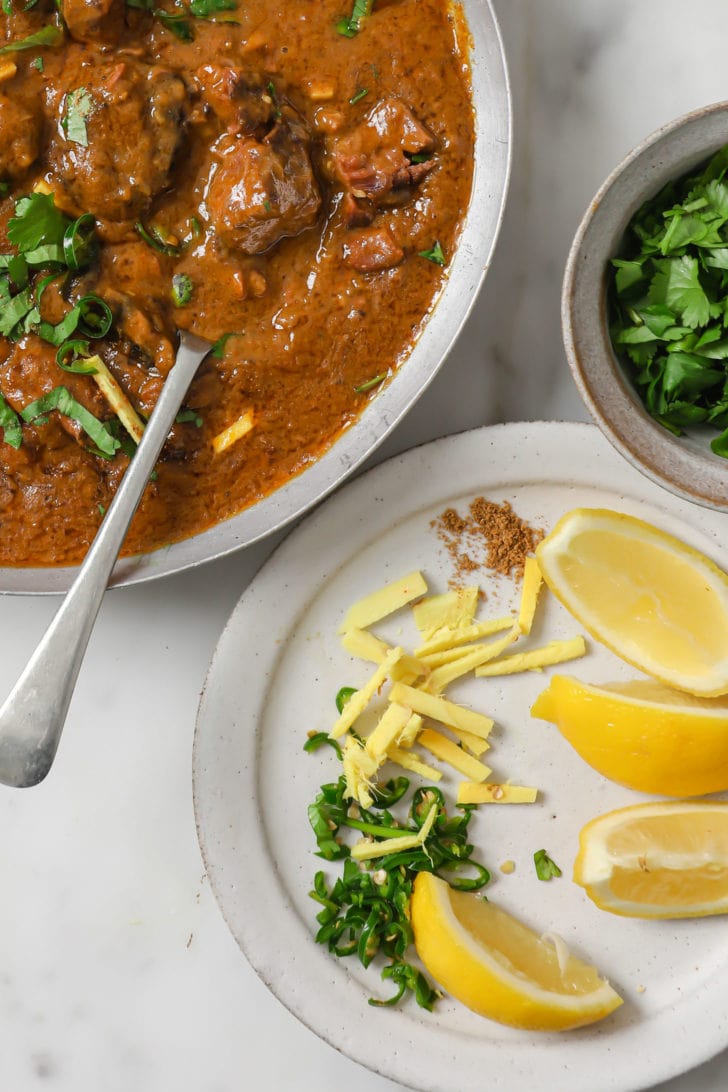
FAQs
To thicken Nihari, allow it to cook uncovered so that it reduces down. You can also add more atta than is called for in the recipe.
Yes! Because it’s a stew with no vegetables or water-based ingredients, Nihari is naturally freezer-friendly. It’s best reheated on the stovetop with some extra water. Be mindful with stirring so the beef doesn’t break.
I haven’t tried making with chicken yet, so I can’t say what changes it’ll need in terms of spices & balance. If you’re wanting to use chicken, you’ll cook for much less time (bone-in chicken pieces have a cook time of around 30 minutes over low heat).
To double the recipe, double everything but the water. A rough estimate: If using a slow cooker, use 2 cups per pound of beef instead of 3 or 3 1/2. If making it over the stovetop, use 6 cups instead of 9 cups per pound.
Tried this recipe? If you have a minute, please leave a comment & star rating below and tell me how it was! If you’re on Instagram, please tag me so I can see your creations. I truly love hearing from you! Thank you!
More Pakistani Beef Recipes You’ll Love
- Pakistani Beef Kofta Curry (Meatball Curry)
- Easy Pakistani Haleem Recipe (Instant Pot)
- Pakistani Seekh Kebabs (Ground Beef Skewers)
- Chapli Kabab
- Easy Instant Pot Pakistani Beef Curry (Stew)
- Aloo Keema (Ground Beef & Potato Curry)
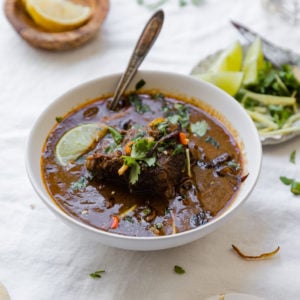
Easy Nihari (Pakistani Beef Stew)
Watch the Video
Ingredients
Whole Spices
- 1/2 piece of a small star anise
- 1-2 small bay leaves
- 1 inch piece cinnamon stick
Ground Spices
- 2-3 whole cloves, ground into a powder using a mortar and pestle
- 2-3 green cardamom pods, seeds ground into a powder using a mortar and pestle
- 1/2 tsp fennel seeds, ground into a powder using a mortar and pestle
- 1/2 tsp paprika powder
- 1/2 tsp coriander powder
- 1/2 tsp cumin powder
- 1/4 tsp turmeric
- 1/4-1/2 tsp red chilli powder or cayenne
- 1/4 tsp crushed red chilli flakes
- 1/4 tsp black pepper powder
- 1/8 tsp garlic powder (optional)
- pinch nutmeg
- 1 tbsp Homemade Nihari Masala (recipe in post), or sub 1/2 tbsp store-bought
Nihari
- 1/3 cup canola or other neutral oil
- 1 tbsp ghee, or butter
- 1 large (250-270 g) onion, thinly sliced
- 5-6 garlic cloves, crushed
- 3/4 inch piece ginger, crushed
- 1 1/4 tsp salt (sea salt or table salt), start with 1 1/2 tsp if using homemade masala
- 1/4 cup (35 g) durum atta flour, (Or sub dry roasted brown rice flour or sorghum flour for GF)
- 9 cups water for stovetop, 3 1/2 cups for slow cooker
- 1 lb (454 g) boneless beef shank meat, 2-inch cubed, or sub beef stew meat, 1 1/2 inch cubed
Garnishings
- 1 tsp garam masala
- crispy fried onions
- 1 inch piece ginger, julienned
- 1 lemon, cut into wedges
- 1/4 bunch fresh cilantro, chopped
- 1-2 green chili peppers, chopped
Equipment
- Dutch oven OR Slow Cooker
Instructions
Stovetop
- Heat oil and ghee in a heavy-bottomed Dutch oven or pot over medium-high heat. Add the whole spices and onion, and sauté until the onion turns golden, about 10 minutes.
- If needed, deglaze with 2 tbsp of water. Once the water dries up, add the garlic and ginger and continue to sauté for 30 seconds. Add beef and sauté for about 5 minutes, or until it changes color.
- Lower the heat and add the powdered spices and salt and sauté for about 20 seconds. Immediately pour in the water and stir to mix.
- Raise the heat to high and bring to a boil (cover with lid to make it boil quicker). Then lower the heat to low/low-medium so that the nihari is gently simmering. Cover and allow to cook for 6 hours for beef shank meat (or ~4 hours for stew meat). Turn off the heat. The meat should be tender enough that it breaks easily when pressed with a wooden spoon. Remove the whole spices, if desired.
- Take out a cup of the liquid of the Nihari onto a bowl or measuring cup. Let it cool a little by adding an ice cube to it. Place the atta in another small bowl. Bit by bit, whisk the Nihari liquid into the atta to form a smooth slurry (small clumps are okay). Slowly stir this slurry back in to the Nihari pot to prevent clumps. If the mixture is too thick, add (preferably boiling) water to reach desired consistency.
- Raise the heat to high to bring to a simmer. Then lower the heat to low/low medium. Cover and allow the nihari to simmer for another 30-45 minutes. The consistency should be like a thick soup. Serve hot with the garnishing and naan or sheermal.
Slow Cooker
- Heat a medium pot over medium-high heat. Heat oil and ghee and add the whole spices. Add onion and sauté until golden, about 10 minutes.
- If needed, deglaze with 2 tbsp of water. Once the water dries up, add the garlic and ginger and continue to sauté for 30 seconds. Add beef and sauté for about 5 minutes, or until it changes color.
- Lower the heat and add the powdered spices and salt and sauté for about 20 seconds.
- Carefully pour this beef mixture into your Crockpot or slow cooker.
- Add the water and stir to mix. Cook on low for 8 (for stew) to 10 hours (for shanks) or high for 6-7 hours, or until the beef is fall-apart tender. Cooking times will vary depending on your meat and slow cooker.
- Toward the end of your cooking time, remove your whole spices and take out a cup of the liquid of the Nihari into a bowl. Let it cool a little by adding an ice cube to it. Place the atta attain another bowl. Bit by bit, add the Nihari liquid to the atta to form a smooth slurry. Slowly add this slurry back into the crockpot while stirring to prevent clumps. Let it cook for another 30-45 minutes. Serve hot with the garnishing and naan or sheermal.


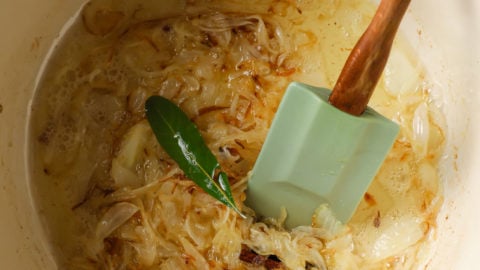
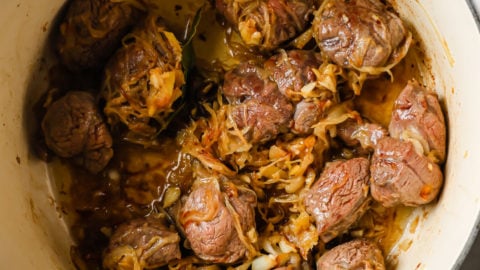
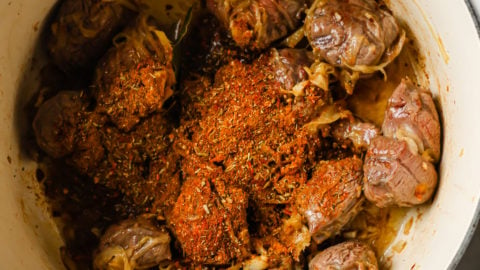
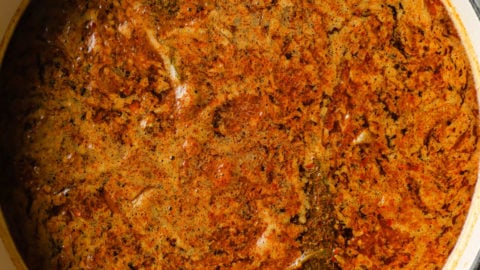
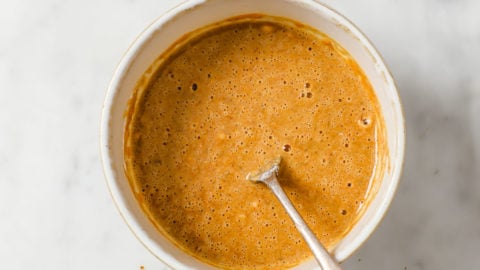
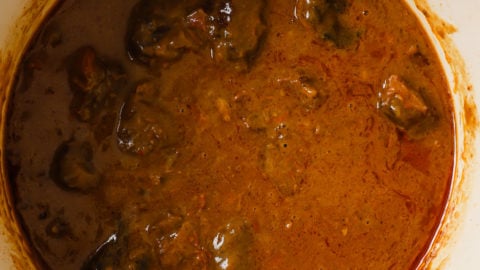
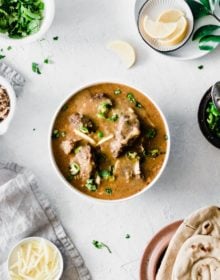
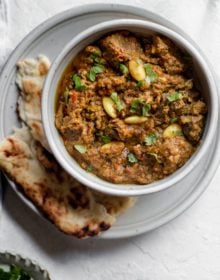
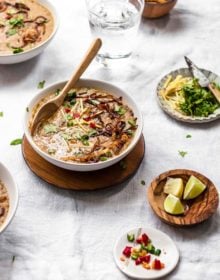

152 Comments on “Easy Nihari (Pakistani Beef Stew) – Stovetop + Slow Cooker”
Hi Izzah,
I haven’t made this yet but I will be. If I can’t get any atta, could I use cornflour slurry to thicken it? I’m from Ireland, more than likely there’s a place I might be able get atta but I’m just wondering would a cornflour slurry work?
Kind regards
Seán
Hi Sean, I don’t recommend cornflour/cornstarch because it just gives it a gloopy instead of smooth texture after refrigeration. But I’ve heard from several who’ve used it in place with success. You can also use AP flour or other type of flour. Hope you enjoy!
Love your blog – awesome pakistani recipes – reminds me of my dadi’s cooking🙂
I’m keen to try your nalli recipe but I’m confused on whether to make the slow cooker version or the instant pot version. The IP version looks easier but I’m not sure if it will taste as good and authentic as the slow cooker version?
Would be great to get your advice on which one tastes better
Thanks
Thanks so much, Tej! I think slow cooking definitely enhances flavor so if you’re willing to wait a little longer, go for this one.
Came out really good. Thank you for the step by step instructions. Kids loved it too.
So glad to hear that. Thank you, Beena!
Hi Izzah!
Tried this recipe today and unfortunately the beef fell apart. I think the amount of water when doubling the meat (2lb beef stew meat) is incorrect. I used 14 cups of water and cooked on low heat for 4 hours. I then added the atta as you suggested but there was so much water that by the time it cooked down (almost 2 additional hours uncovered), the beef was really overcooked. I even added more atta than suggested since it was taking too long to thicken. I think maybe 10 cups for 2lb would have been better. Normally love your recipes but this one didn’t work out for me. 🙁
Hi Anne, I’m sorry to hear that. I think you’re right – whenever we double recipes, there’s always a chance the water content will be too much. I’ll make a note of that to prevent that happening to others & will revisit the water amount. Thank you for sharing this with me. I really appreciate it! And once again I’m sorry about it not working out!
Just dropping in to say this is exactly how I expect my nihari to be!! Also so happy to find a recipe that doesn’t require a masala packet. Btw… I misread the elaichi instructions and totally thought you meant to deseed it and grind the husk lol… I thought it was a bit odd, but I figured maybe you had reasons so that’s what I did. Then halfway through I read someone else’s comment and realized what it actually meant. 🤦♀️ So I just tossed an extra pod in and it worked out fine. But you may want to rephrase it a bit!
Now two questions… firstly, how much do you brown the onions? Mine were golden brown bordering on dark brown, but yours looked much lighter.
And secondly… I think 9.5 cups of water might be too much? I cooked it covered before adding flour, and uncovered after, but even after that I had to really boil it down to get it to thicken. Any thoughts?
Hello! Thank you for pointing that out – I’ll go ahead and reword. And yes – my photographer has to take the pot upstairs & photograph so she doesn’t risk it with getting them too brown! The video shows me cooking it so you can use that to cross-reference in the future.
Regarding the water – I’ve given a range because it really depends on the thickness of your pot, heat of the stove, etc. You can definitely adjust according to your preference. Please let me know if you have any other questions!
Hey! I’m so sorry I forgot to reply. Thanks for the info!! I’ll try with less water next time. Also just wanted to thank you again for the recipe – it’s perfect!
And now that I’ve posted my comment and gone back to check out the video, I’ve realized it’s missing! Any idea what is going on?
Izza
I LOVE your blog. Thank you for sharing these receipes.
How long do you cook it in the slow cooker?
I read the entire receipe but couldn’t find the answer.
I am going to using the slow cooker option on my intant pot.
Also, is Caraway the same as cumin seeds?
Best Wishes,
Suzie
Thank you so much, Suzie! I apologize for the late response! The slow cooker instructions are below the stovetop..8-10 hours. No, caraway seeds (called shahi zeera) are different than cumin in taste and scent. Feel free to omit if you can’t find!
Jazakillahu khair for this amazing recipe I have tried it a few times now and it is an absolute hit. The fine details regarding spices etc. are super helpful, I was so nervous to make this the first time but Alhamdulillah it’s turned out a treat.
So glad to hear that, Sadia! Thank you for sharing!!
Hi! Love this recipe! I am actually Punjabi (from India) but I make this for my in-laws who are from Karachi and they are always so impressed so thank you for that!
Quick question what do you think about making this 2 days ahead of time? Should I just store it in the fridge and then slowly reheat it on the stove top or in the oven? Do you think the flavors will change it all?!
Thanks!
Thanks for the recipe! One question is my beef chunks fell apart during cooking. Any ideas how to prevent that in the future?
Also, my broth wasn’t as dark as yours, any ideas what happened?
Thank you!!
Hi Shana, I’m so sorry to hear that! Did you use beef shank or stew meat? Beef cooking times vary so much depending on stove, type/age of beef, etc. I just updated with a rough time estimate for beef stew to prevent that for others. As for not being as dark, it could be that your onions weren’t as brown before you added the remaining ingredients. It doesn’t need to be very dark so I think you’re good there!
Thank you so much, Jazakallah! And thank you for your lovely blog. It has been so helpful. One more question. I noticed some recipes call for onions in beginning and some call for at end. Do you think beginning is best? Do they just break down over the course of cooking?
Also, have you ever had the flour clump up while adding?
Thanks so much, Shana! I haven’t tried adding the onions at the end. (Had to try to stick to the original recipe so couldn’t experiment too much.) I did it this way for ease vs frying onions, grinding, etc. And yes, they do break down, for the most part, when slow cooked.
The flour clumps happen when flour expands too quickly when mixed with hot water. I have had flour clump up when I didn’t allow the liquid to cool. To prevent that, make sure the nihari broth has cooled down before making the slurry. Hope that helps and let me know if you have any other questions!
As a revert i don’t have anyone to teach me the art of cooking desi foods. Your recipes are amazing and me and my family love them. Thank you x
Makes me so happy to hear that. Thank you for sharing, Molly!